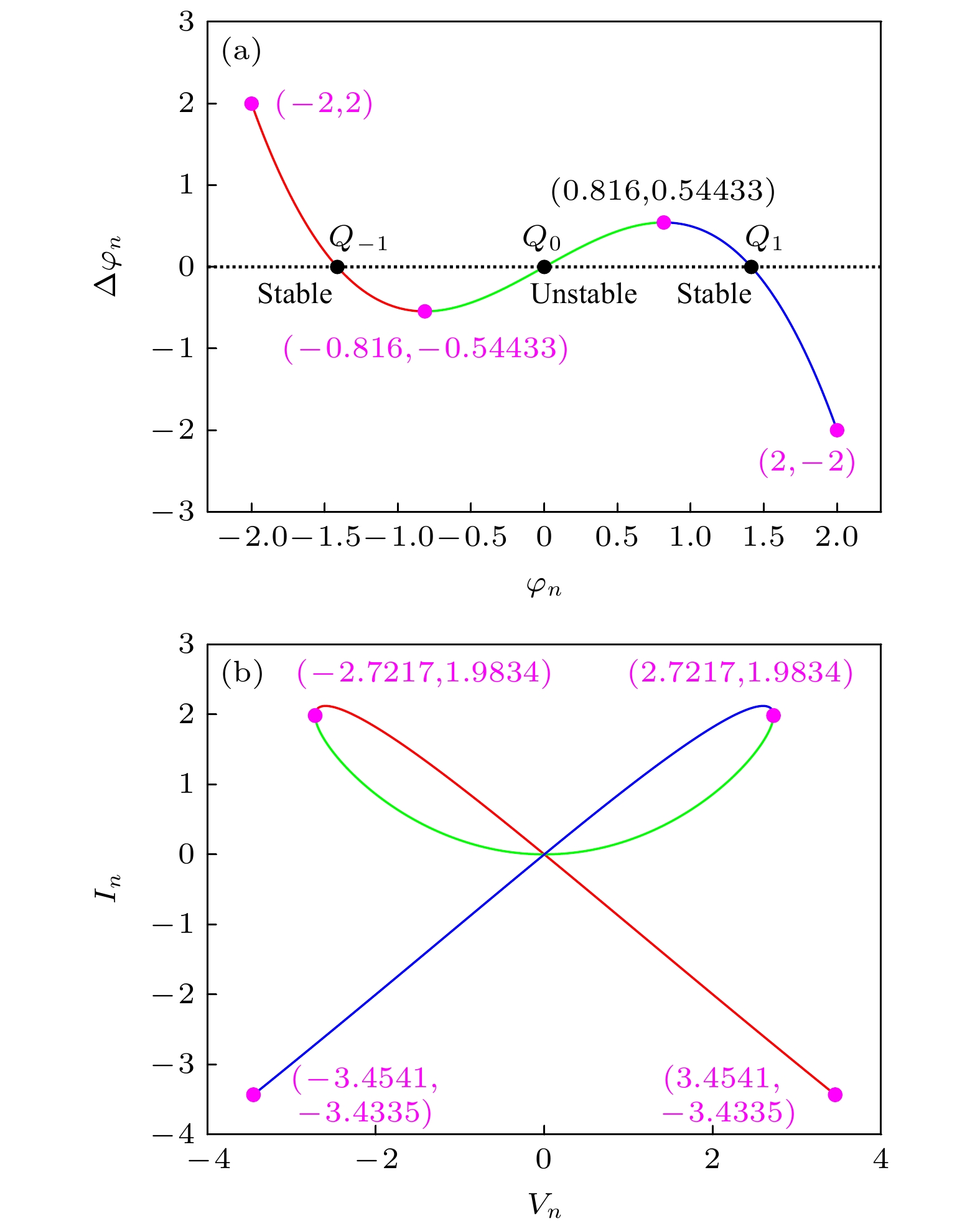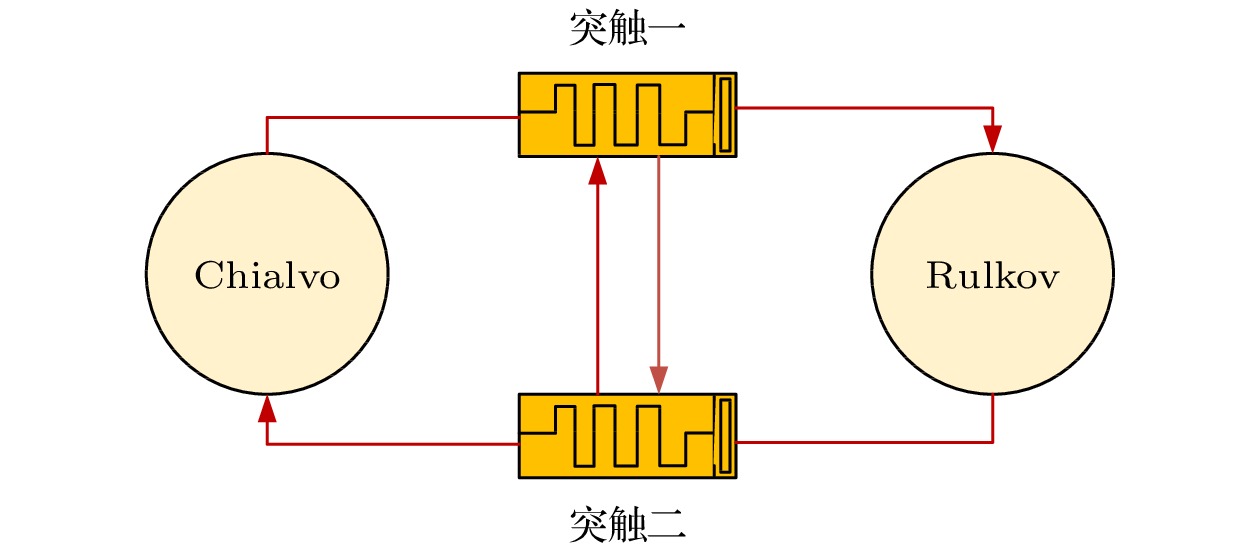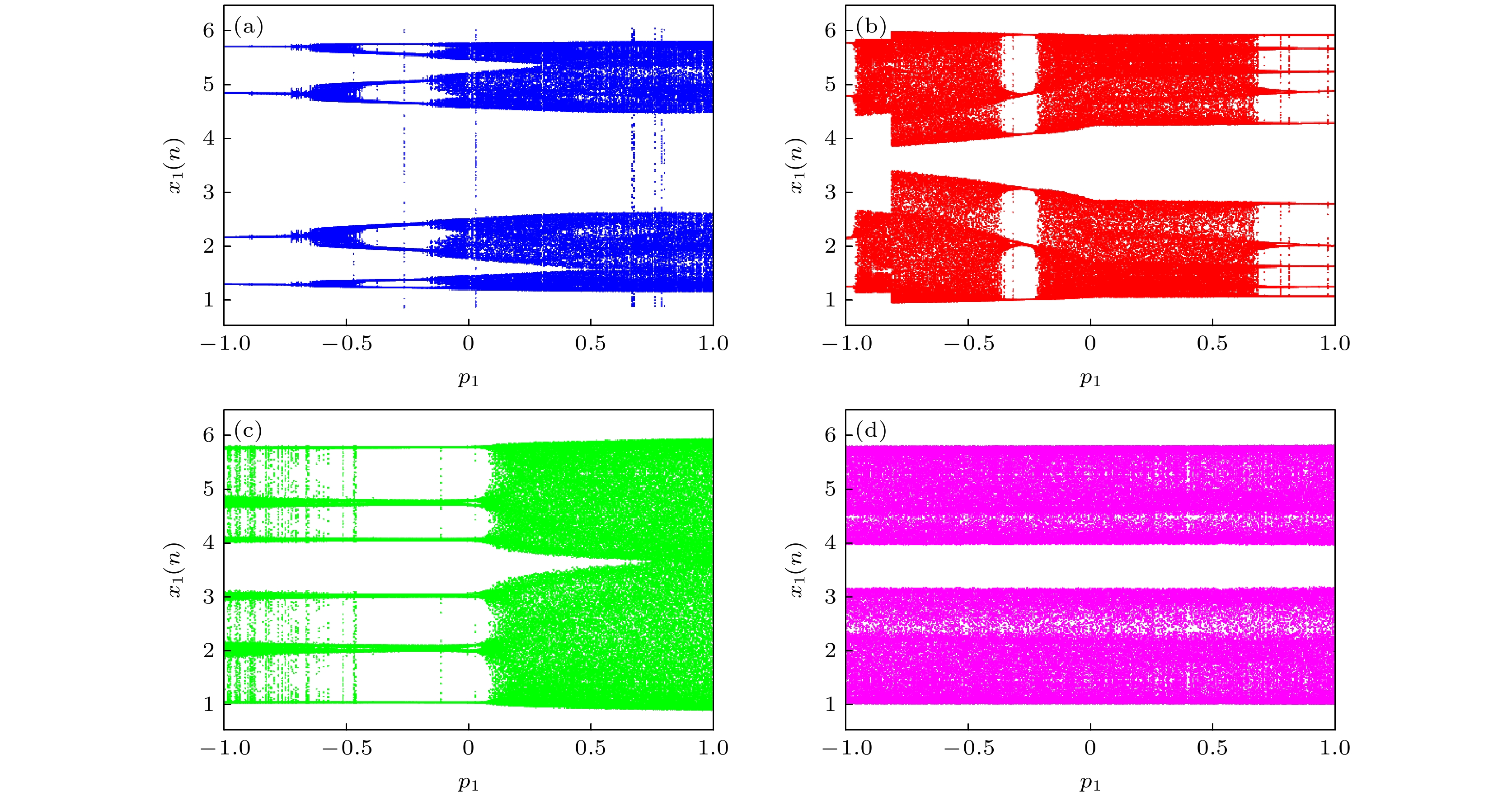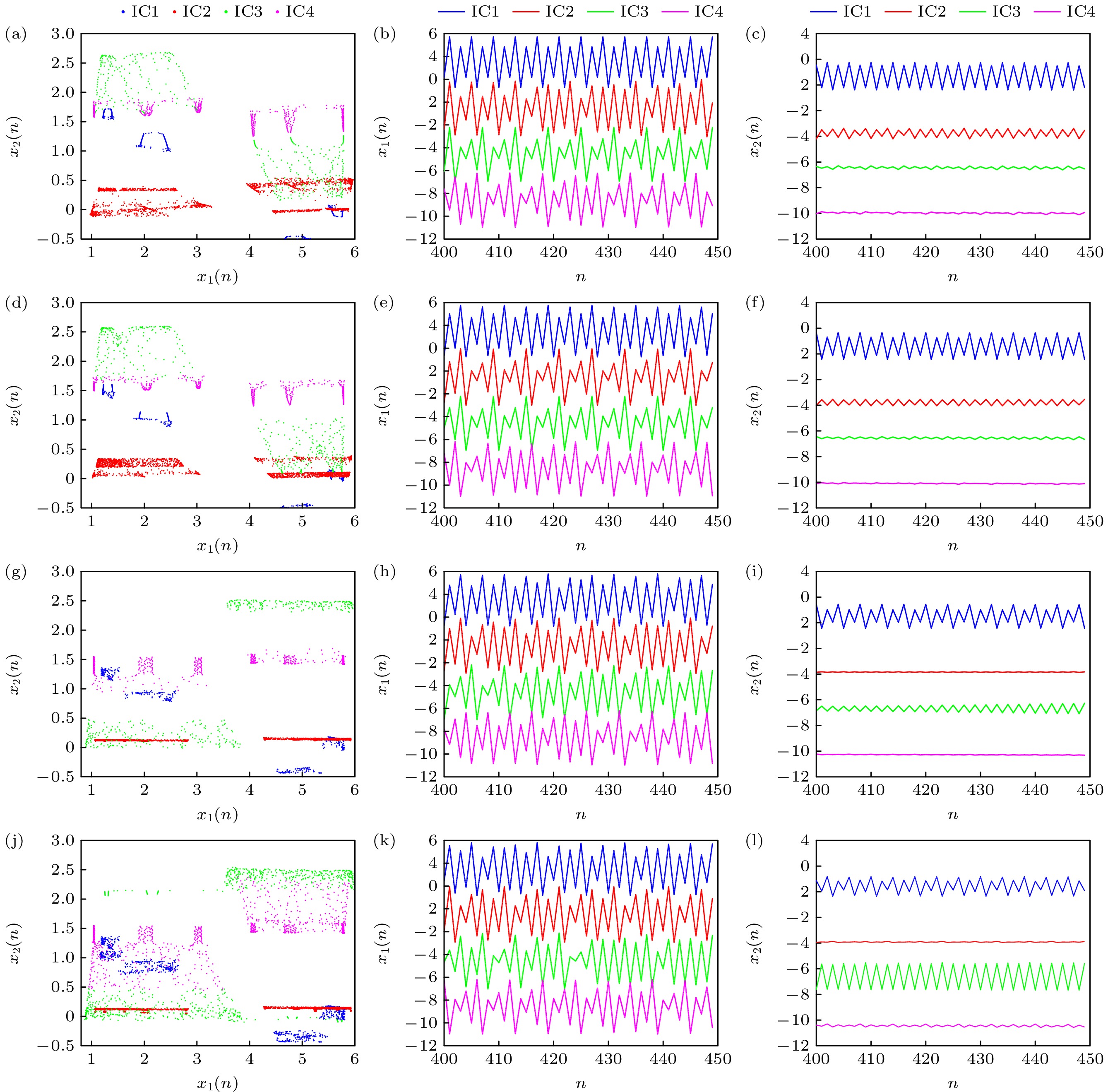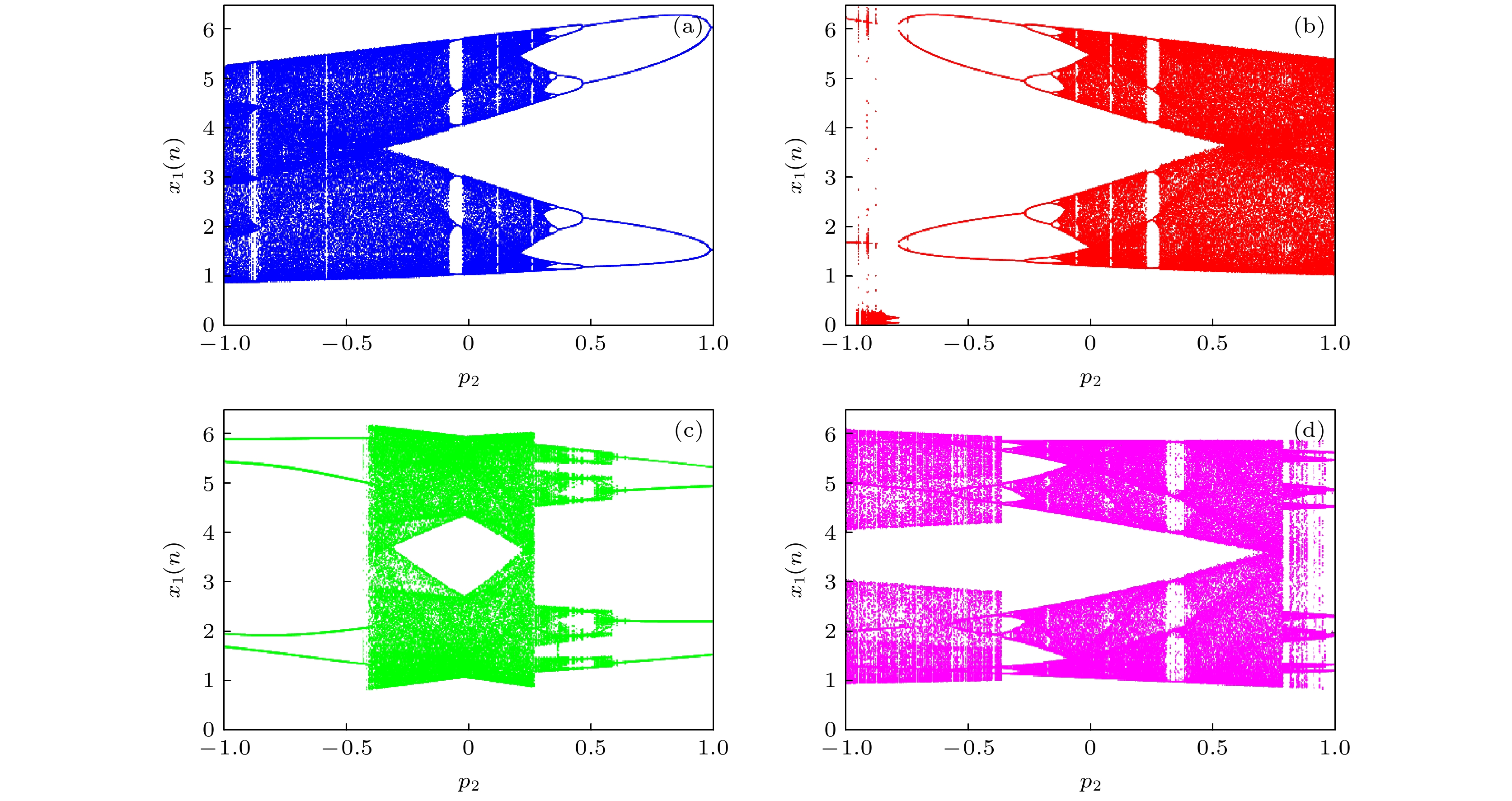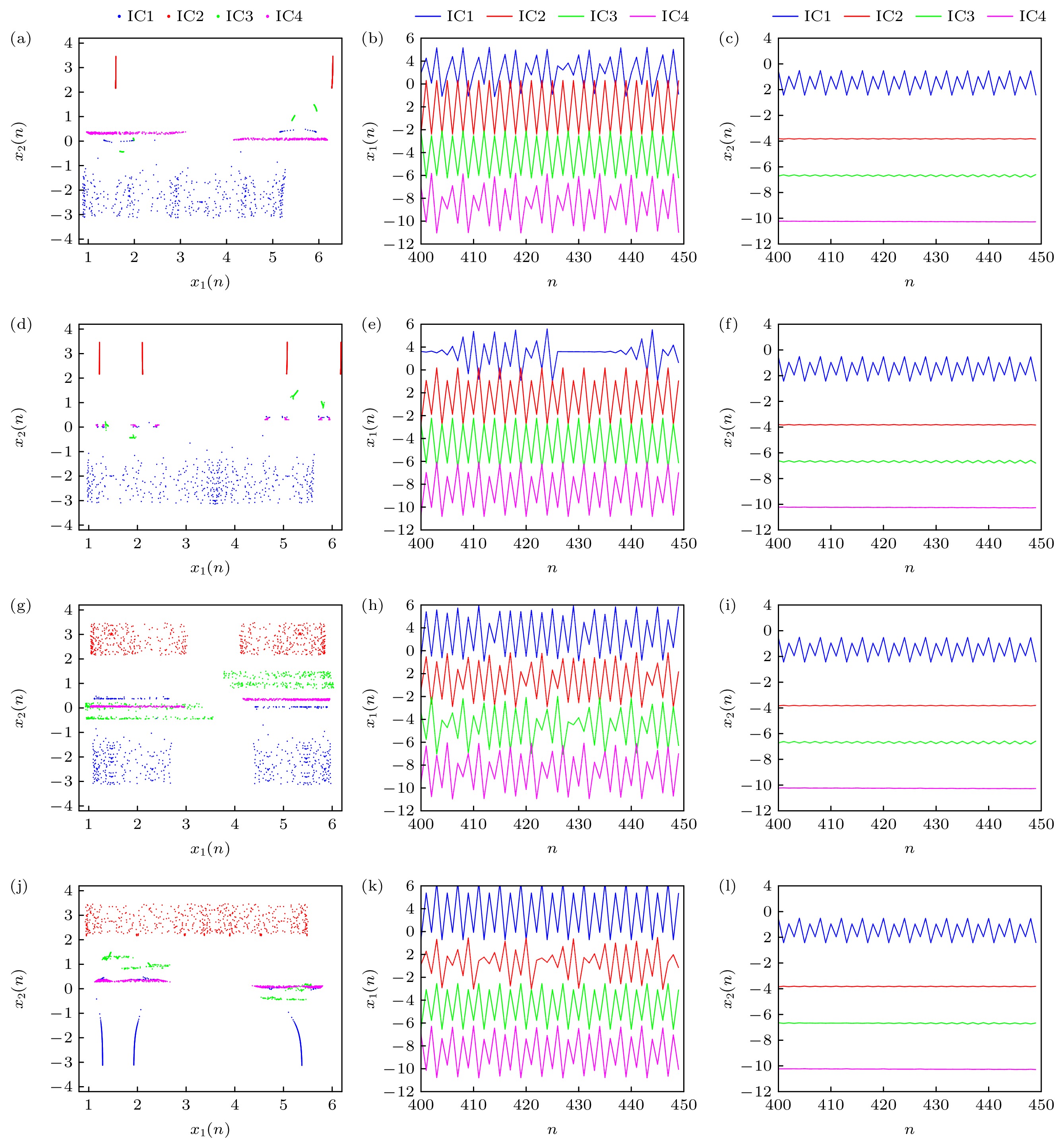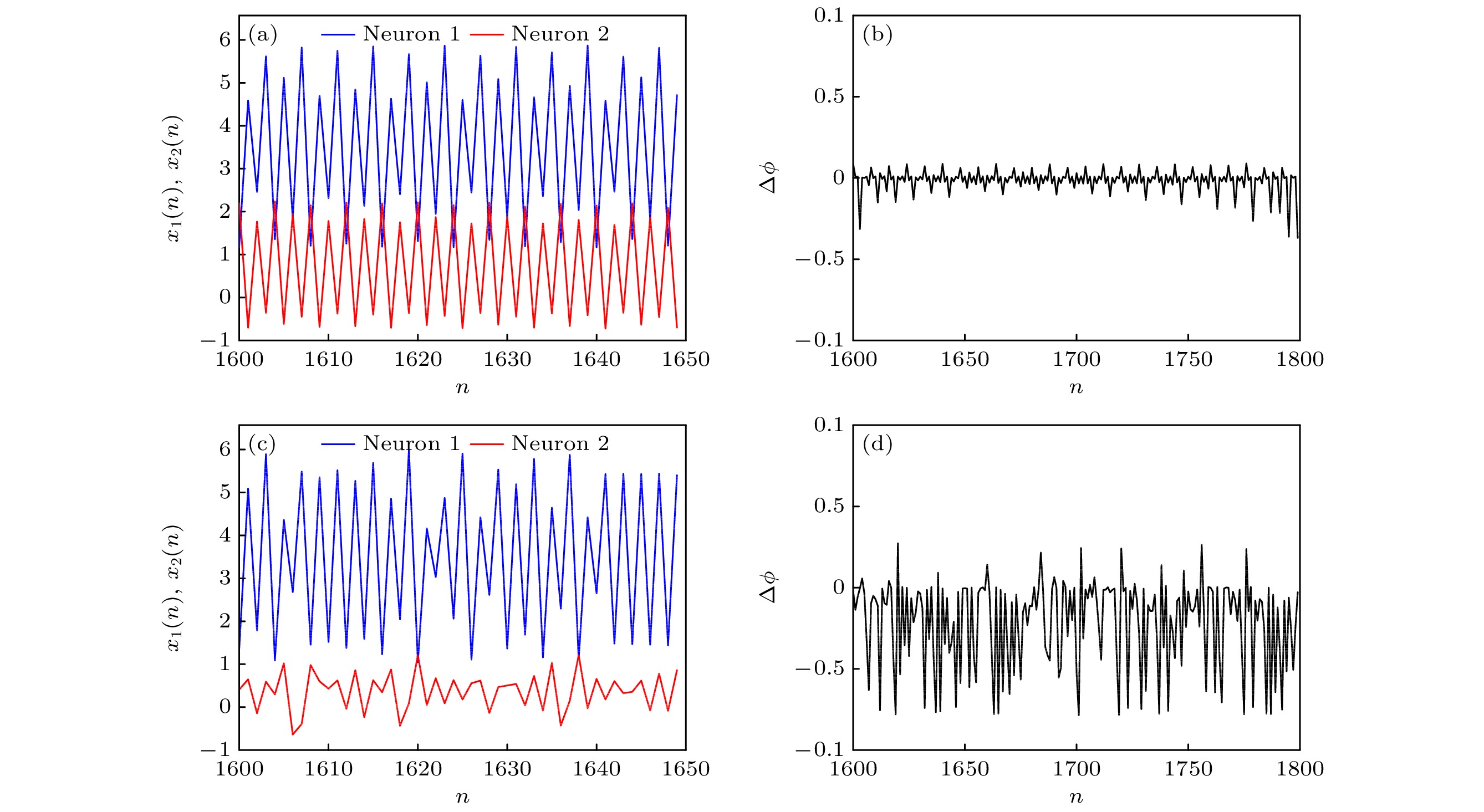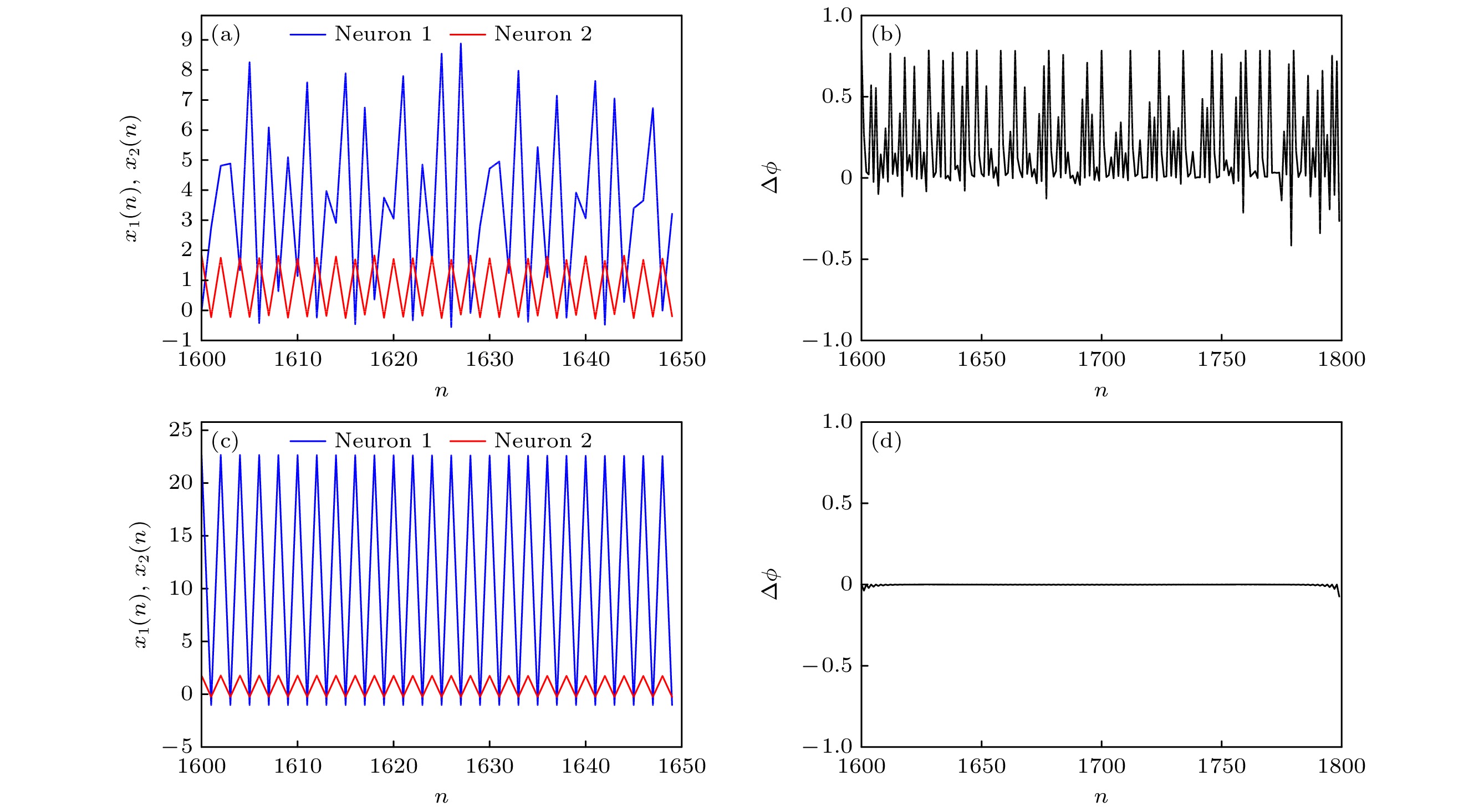-
Synaptic crosstalk, which occurs due to the overflow of neurotransmitters between neighboring synapses, holds a crucial position in shaping the discharge characteristics and signal transmission within nervous systems. In this work, two memristors are employed to simulate biological neural synapses and bidirectionally coupled Chialvo discrete neuron and Rulkov discrete neuron. Thus, a heterogeneous discrete neural network with memristor-synapse coupling is constructed, with the crosstalk behavior between memristor synapses in the coupled state taken into account. The analysis demonstrates that the quantity and stability of fixed points within this neural network greatly depend on the strength of synaptic crosstalk. Additionally, through a thorough investigation of bifurcation diagrams, phase diagrams, Lyapunov exponents, and time sequences, we uncover the multi-stable state property exhibited by the neural network. This characteristic manifests as the coexistence of diverse discharge behaviors, which significantly change with the intensity of synaptic crosstalk. Interestingly, the introduction of control parameter into state variables can lead the bias to increase, and also the infinite stable states to occur in the neural network. Furthermore, we comprehensively study the influence of synaptic crosstalk strength on the synchronization behavior of the neural network, with consideration of various coupling strengths, initial conditions, and parameters. Our analysis, which is based on the phase difference and synchronization factor of neuronal discharge sequences, reveales that the neural network maintains phase synchronization despite the variations of the two crosstalk strengths. The insights gained from this work provide important support for elucidating the electrophysiological mechanisms behind the processing and transmission of biological neural information. Especially, the coexisting discharge phenomenon in the neural network provides an electrophysiological theoretical foundation for the clinical symptoms and diagnosis of the same neurological disease among different individuals or at different stages. And the doctors can predict the progression and prognosis of neurological disease based on the patterns and characteristics of coexisting discharge in patients, enabling them to adopt appropriate intervention measures and monitoring plans. Therefore, the research on coexisting discharge in the neural system contributes to the comprehensive treatment of nervous system disease.
-
Keywords:
- memristor /
- heterogeneous discrete neural network /
- synaptic crosstalk /
- coexisting discharge /
- phase synchronization
[1] 白婧, 关富荣, 唐国宁 2021 物理学报 70 170502
 Google Scholar
Google Scholar
Bai J, Guan F R, Tang G N 2021 Acta Phys. Sin. 70 170502
 Google Scholar
Google Scholar
[2] Stein R B, Gossen E R, Jones K E 2005 Nat. Rev. Neurosci. 6 389
[3] 安新磊, 乔帅, 张莉 2021 物理学报 70 050501
 Google Scholar
Google Scholar
An X L, Qiao S, Zhang L 2021 Acta Phys. Sin. 70 050501
 Google Scholar
Google Scholar
[4] Tan F, Zhou L L, Lu J W, Quan, H Z, Liu K Y 2022 Eur. J. Control 70 100764
[5] 徐泠风, 李传东, 陈玲 2016 物理学报 65 240701
 Google Scholar
Google Scholar
Xu L F, Li C D, Chen L 2016 Acta Phys. Sin. 65 240701
 Google Scholar
Google Scholar
[6] Liu B, Peng X N, Li C L 2024 Int. J. Electron. Commun. 178 155283
[7] Guo M, Zhu Y L, Liu R Y, Zhao K X, Dou G 2021 Neurocomputing 472 12
[8] 徐聪, 王春华, 孙晶茹 2023 中国科学: 信息科学 53 164
 Google Scholar
Google Scholar
Xu C, Wang C H, Sun J R 2023 Sci. Sin. Inf. 53 164
 Google Scholar
Google Scholar
[9] 张美娇, 张建刚, 魏立祥, 南梦冉 2021 中国医学物理学杂志 38 1273
Zhang M J, Zhang J G, Wei L X, Nan M R 2021 Chin. J. Med. Phys. 38 1273
[10] Xu Q, Zhu D 2020 IETE Tech. Rev. 38 563
[11] Lu Y C, Li H M, Li C L 2023 Neurocomputing 544 126246
 Google Scholar
Google Scholar
[12] Li C L, Yang Y Y, Yang X B, Zi X Y, Xiao F L 2022 Nonlinear Dyn. 108 1697
 Google Scholar
Google Scholar
[13] Li C L, Wang X, Du J R, Li Z J 2023 Nonlinear Dyn. 111 21333
 Google Scholar
Google Scholar
[14] Tian Z K, Zhou D 2019 Front. Comput. Neurosci. 14 40
[15] Ma M L, Xiong K L, Li Z J Sun Y C 2023 Mathematics 11 375
 Google Scholar
Google Scholar
[16] Bashkirtseva I A, Nasyrova V, Ryashko L B 2018 Chaos, Solitons Fractals 110 76
 Google Scholar
Google Scholar
[17] Kinouchi O, Tragtenberg M H R 1996 Int. J. Bifurcation Chaos 6 2343
 Google Scholar
Google Scholar
[18] Girardi-Schappo M, Tragtenberg M H, Kinouchi O 2013 J. Neurosci. Methods 220 116
 Google Scholar
Google Scholar
[19] Rosenblatt F 1963 Am. J. Psychol. 76 705
 Google Scholar
Google Scholar
[20] Li H D, Li C L, He S B 2023 Int. J. Bifurcation Chaos 33 2350032
 Google Scholar
Google Scholar
[21] 郭慧朦, 梁燕, 董玉姣, 王光义 2023 物理学报 72 070501
 Google Scholar
Google Scholar
Guo H M, Liang Y, Dong Y J, Wang G Y 2023 Acta Phys. Sin. 72 070501
 Google Scholar
Google Scholar
[22] Zhou L L, Lin H C, Tan F 2023 Chaos, Solitons Fractals 173 113643
 Google Scholar
Google Scholar
[23] 秦铭宏, 赖强, 吴永红 2022 物理学报 71 160502
 Google Scholar
Google Scholar
Qin M H, Lai Q, Wu Y H 2022 Acta Phys. Sin. 71 160502
 Google Scholar
Google Scholar
[24] 吴朝俊, 方礼熠, 杨宁宁 2024 物理学报 73 010501
 Google Scholar
Google Scholar
Wu C J, Fang L Y, Yang N N 2024 Acta Phys. Sin. 73 010501
 Google Scholar
Google Scholar
[25] Chua L O 2005 Int. J. Bifurcation Chaos 15 3435
 Google Scholar
Google Scholar
[26] Jin P P, Wang G Y, Liang Y, Iu H H, Chua L O 2021 IEEE Trans. Circuits Syst. Regul. Pap. 68 4419
 Google Scholar
Google Scholar
[27] Lai Q, Yang L 2022 Chaos, Solitons Fractals 165 112781
 Google Scholar
Google Scholar
[28] Li K X, Bao H, Li H Z, Ma J, Hua Z Y, Bao B C 2021 IEEE Trans. Ind. Inf. 18 1726
[29] Lu Y M, Wang C H, Deng Q L, Xu C 2022 Chin. Phys. B 31 060502
 Google Scholar
Google Scholar
[30] Kawahara M, Kato‐Negishi M, Tanaka K 2017 Metallomics 9 619
 Google Scholar
Google Scholar
[31] A N Shrivastava, A Triller, W Sieghart 2011 Front. Cell. Neurosci. 5 7
[32] Li Z J, Yi Z 2022 Electron. Lett. 58 539
 Google Scholar
Google Scholar
[33] Ding D W, Chen X Y, Yang Z L, Hu Y B, Wang M Y, Zhang H W, Zhang X 2022 Chaos, Solitons Fractals 158 112014
 Google Scholar
Google Scholar
[34] Li Z J, Peng C, Wang M J, Ma M L 2024 Indian J. Phys. 98 1043
 Google Scholar
Google Scholar
[35] Ma M L, Xiong K L, Li Z J, He S B 2024 Chin. Phys. B 33 028706
 Google Scholar
Google Scholar
[36] Pool R 1989 Science 243 604
 Google Scholar
Google Scholar
[37] Adhikari S P, Sah M P, Kim H, Chua L O 2013 IEEE Trans. Circuits Syst. Regul. Pap. 60 3008
 Google Scholar
Google Scholar
[38] Ren L J, Mou J, Banerjee S, Zhang Y S 2023 Chaos, Solitons Fractals 167 113024
 Google Scholar
Google Scholar
[39] Li C, Yi C, Li Y, Mitro S, Wang Z 2024 Chaos 34 031102
 Google Scholar
Google Scholar
[40] Ma C G, Mou J, Xiong L, Banerjee S, Liu T M, Han X T 2021 Nonlinear Dyn. 103 2867
 Google Scholar
Google Scholar
[41] Li C, Wang X, Chen G 2017 Nonlinear Dyn. 90 1335
 Google Scholar
Google Scholar
[42] Li C, Gao Y, Lei T, Li RY, Xu Y 2024 Int. J. Bifurcation Chaos 34 2450008
 Google Scholar
Google Scholar
-
图 1 忆阻器的电压-电流特性曲线 (a) $\varphi $(0) = 0.1, ω = 0.1, A = 0.2, 0.3, 0.4; (b) $\varphi $(0) = 0.1, A = 0.5, ω = 0.2, 0.4, 0.8; (c) A = 0.5, ω = 0.2, $\varphi $(0) = –3.0, 0.1, 3.0
Figure 1. Hysteresis loop for discrete memristor: (a) $\varphi $(0) = 0.1, ω = 0.1 and A = 0.2, 0.3, 0.4; (b) $\varphi $(0) = 0.1, A = 0.5 and ω = 0.2, 0.4, 0.8; (c) A = 0.5, ω = 0.2 and $\varphi $(0) = –3.0, 0.1, 3.0.
图 4 不同初始条件时, 状态变量x1(n)关于p1的分岔图 (a) (1, 1, 1, –1, 1, 0); (b) (1, 1, 1, –2.4, 1, 0); (c) (1, 1, 1, 1, 1, 0); (d) (1, 1, 1, 2, 1, 0)
Figure 4. Bifurcation diagrams of state variable x1(n) versus p1 under different initial conditions: (a) (1, 1, 1, –1, 1, 0); (b) (1, 1, 1, –2.4, 1, 0); (c) (1, 1, 1, 1, 1, 0); (d) (1, 1, 1, 2, 1, 0).
图 6 不同初始条件时状态变量x1(n)关于p2的分岔图 (a) (1, 1, 1, –5, 1, 0); (b) (1, 1, 1, 5, 1, 0); (c) (1, 1, 1, –1, 1, 0); (d) (1, 1, 1, –3, 1, 0)
Figure 6. Bifurcation diagrams of state variable x1(n) versus p2 under different initial conditions: (a) (1, 1, 1, –5, 1, 0); (b) (1, 1, 1, 5, 1, 0); (c) (1, 1, 1, –1, 1, 0); (d) (1, 1, 1, –3, 1, 0).
表 1 神经网络的平衡点、特征值和稳定性
Table 1. Equilibrium points, eigenvalues, and stability of neural network.
(p1, p2) (x1(n), y2(n), $\varphi $1(n), $\varphi $2(n)) 特征值 稳定性 (0.1, 0.1) (0.0342, 0.001, 0.0323, 0.0086) –0.5593, 0.8269, 0.8889, 0.9994±0.0022i, 1 不稳定鞍焦点 (0.0352, 0.001, 0.036, –0.3372) –0.5593, 0.8509, 0.8291, 0.8881, 0.9990, 0.9996 不稳定鞍结点 (0.0392, 0.0021, –0.2489, –0.3372) –0.5587, 0.8296, 0.9425, 0.9017, 0.8926, 0.9994 不稳定鞍结点 (168.8416, 0.0715, –0.7368, –0.3416) 0, 0.8900, –0.5580, 0.1857, 0.8236, 0.9994 不稳定鞍结点 (1, 1) (0.0339, 0.0009, 0.0973, –0.0618) –0.5589, 0.8097, 0.8892, 0.9953±0.0015i, 0.9995 不稳定鞍焦点 (0.0347, 0.0018, 0.1062, –0.3375) –0.5586, 0.8277±0.0047i, 0.8890, 0.9955, 0.9994 不稳定鞍焦点 (0.0383, 0.0031–0.224, –0.3365) –0.5569, 0.8305, 0.8838±0.0020i, 0.9645, 0.9994 不稳定鞍焦点 (168.8425, 0.1017, –0.7368, –0.3416) 0, 0.89, –0.5457, 0.1857, 0.8113, 0.9994 不稳定鞍结点 -
[1] 白婧, 关富荣, 唐国宁 2021 物理学报 70 170502
 Google Scholar
Google Scholar
Bai J, Guan F R, Tang G N 2021 Acta Phys. Sin. 70 170502
 Google Scholar
Google Scholar
[2] Stein R B, Gossen E R, Jones K E 2005 Nat. Rev. Neurosci. 6 389
[3] 安新磊, 乔帅, 张莉 2021 物理学报 70 050501
 Google Scholar
Google Scholar
An X L, Qiao S, Zhang L 2021 Acta Phys. Sin. 70 050501
 Google Scholar
Google Scholar
[4] Tan F, Zhou L L, Lu J W, Quan, H Z, Liu K Y 2022 Eur. J. Control 70 100764
[5] 徐泠风, 李传东, 陈玲 2016 物理学报 65 240701
 Google Scholar
Google Scholar
Xu L F, Li C D, Chen L 2016 Acta Phys. Sin. 65 240701
 Google Scholar
Google Scholar
[6] Liu B, Peng X N, Li C L 2024 Int. J. Electron. Commun. 178 155283
[7] Guo M, Zhu Y L, Liu R Y, Zhao K X, Dou G 2021 Neurocomputing 472 12
[8] 徐聪, 王春华, 孙晶茹 2023 中国科学: 信息科学 53 164
 Google Scholar
Google Scholar
Xu C, Wang C H, Sun J R 2023 Sci. Sin. Inf. 53 164
 Google Scholar
Google Scholar
[9] 张美娇, 张建刚, 魏立祥, 南梦冉 2021 中国医学物理学杂志 38 1273
Zhang M J, Zhang J G, Wei L X, Nan M R 2021 Chin. J. Med. Phys. 38 1273
[10] Xu Q, Zhu D 2020 IETE Tech. Rev. 38 563
[11] Lu Y C, Li H M, Li C L 2023 Neurocomputing 544 126246
 Google Scholar
Google Scholar
[12] Li C L, Yang Y Y, Yang X B, Zi X Y, Xiao F L 2022 Nonlinear Dyn. 108 1697
 Google Scholar
Google Scholar
[13] Li C L, Wang X, Du J R, Li Z J 2023 Nonlinear Dyn. 111 21333
 Google Scholar
Google Scholar
[14] Tian Z K, Zhou D 2019 Front. Comput. Neurosci. 14 40
[15] Ma M L, Xiong K L, Li Z J Sun Y C 2023 Mathematics 11 375
 Google Scholar
Google Scholar
[16] Bashkirtseva I A, Nasyrova V, Ryashko L B 2018 Chaos, Solitons Fractals 110 76
 Google Scholar
Google Scholar
[17] Kinouchi O, Tragtenberg M H R 1996 Int. J. Bifurcation Chaos 6 2343
 Google Scholar
Google Scholar
[18] Girardi-Schappo M, Tragtenberg M H, Kinouchi O 2013 J. Neurosci. Methods 220 116
 Google Scholar
Google Scholar
[19] Rosenblatt F 1963 Am. J. Psychol. 76 705
 Google Scholar
Google Scholar
[20] Li H D, Li C L, He S B 2023 Int. J. Bifurcation Chaos 33 2350032
 Google Scholar
Google Scholar
[21] 郭慧朦, 梁燕, 董玉姣, 王光义 2023 物理学报 72 070501
 Google Scholar
Google Scholar
Guo H M, Liang Y, Dong Y J, Wang G Y 2023 Acta Phys. Sin. 72 070501
 Google Scholar
Google Scholar
[22] Zhou L L, Lin H C, Tan F 2023 Chaos, Solitons Fractals 173 113643
 Google Scholar
Google Scholar
[23] 秦铭宏, 赖强, 吴永红 2022 物理学报 71 160502
 Google Scholar
Google Scholar
Qin M H, Lai Q, Wu Y H 2022 Acta Phys. Sin. 71 160502
 Google Scholar
Google Scholar
[24] 吴朝俊, 方礼熠, 杨宁宁 2024 物理学报 73 010501
 Google Scholar
Google Scholar
Wu C J, Fang L Y, Yang N N 2024 Acta Phys. Sin. 73 010501
 Google Scholar
Google Scholar
[25] Chua L O 2005 Int. J. Bifurcation Chaos 15 3435
 Google Scholar
Google Scholar
[26] Jin P P, Wang G Y, Liang Y, Iu H H, Chua L O 2021 IEEE Trans. Circuits Syst. Regul. Pap. 68 4419
 Google Scholar
Google Scholar
[27] Lai Q, Yang L 2022 Chaos, Solitons Fractals 165 112781
 Google Scholar
Google Scholar
[28] Li K X, Bao H, Li H Z, Ma J, Hua Z Y, Bao B C 2021 IEEE Trans. Ind. Inf. 18 1726
[29] Lu Y M, Wang C H, Deng Q L, Xu C 2022 Chin. Phys. B 31 060502
 Google Scholar
Google Scholar
[30] Kawahara M, Kato‐Negishi M, Tanaka K 2017 Metallomics 9 619
 Google Scholar
Google Scholar
[31] A N Shrivastava, A Triller, W Sieghart 2011 Front. Cell. Neurosci. 5 7
[32] Li Z J, Yi Z 2022 Electron. Lett. 58 539
 Google Scholar
Google Scholar
[33] Ding D W, Chen X Y, Yang Z L, Hu Y B, Wang M Y, Zhang H W, Zhang X 2022 Chaos, Solitons Fractals 158 112014
 Google Scholar
Google Scholar
[34] Li Z J, Peng C, Wang M J, Ma M L 2024 Indian J. Phys. 98 1043
 Google Scholar
Google Scholar
[35] Ma M L, Xiong K L, Li Z J, He S B 2024 Chin. Phys. B 33 028706
 Google Scholar
Google Scholar
[36] Pool R 1989 Science 243 604
 Google Scholar
Google Scholar
[37] Adhikari S P, Sah M P, Kim H, Chua L O 2013 IEEE Trans. Circuits Syst. Regul. Pap. 60 3008
 Google Scholar
Google Scholar
[38] Ren L J, Mou J, Banerjee S, Zhang Y S 2023 Chaos, Solitons Fractals 167 113024
 Google Scholar
Google Scholar
[39] Li C, Yi C, Li Y, Mitro S, Wang Z 2024 Chaos 34 031102
 Google Scholar
Google Scholar
[40] Ma C G, Mou J, Xiong L, Banerjee S, Liu T M, Han X T 2021 Nonlinear Dyn. 103 2867
 Google Scholar
Google Scholar
[41] Li C, Wang X, Chen G 2017 Nonlinear Dyn. 90 1335
 Google Scholar
Google Scholar
[42] Li C, Gao Y, Lei T, Li RY, Xu Y 2024 Int. J. Bifurcation Chaos 34 2450008
 Google Scholar
Google Scholar
Catalog
Metrics
- Abstract views: 4953
- PDF Downloads: 126
- Cited By: 0














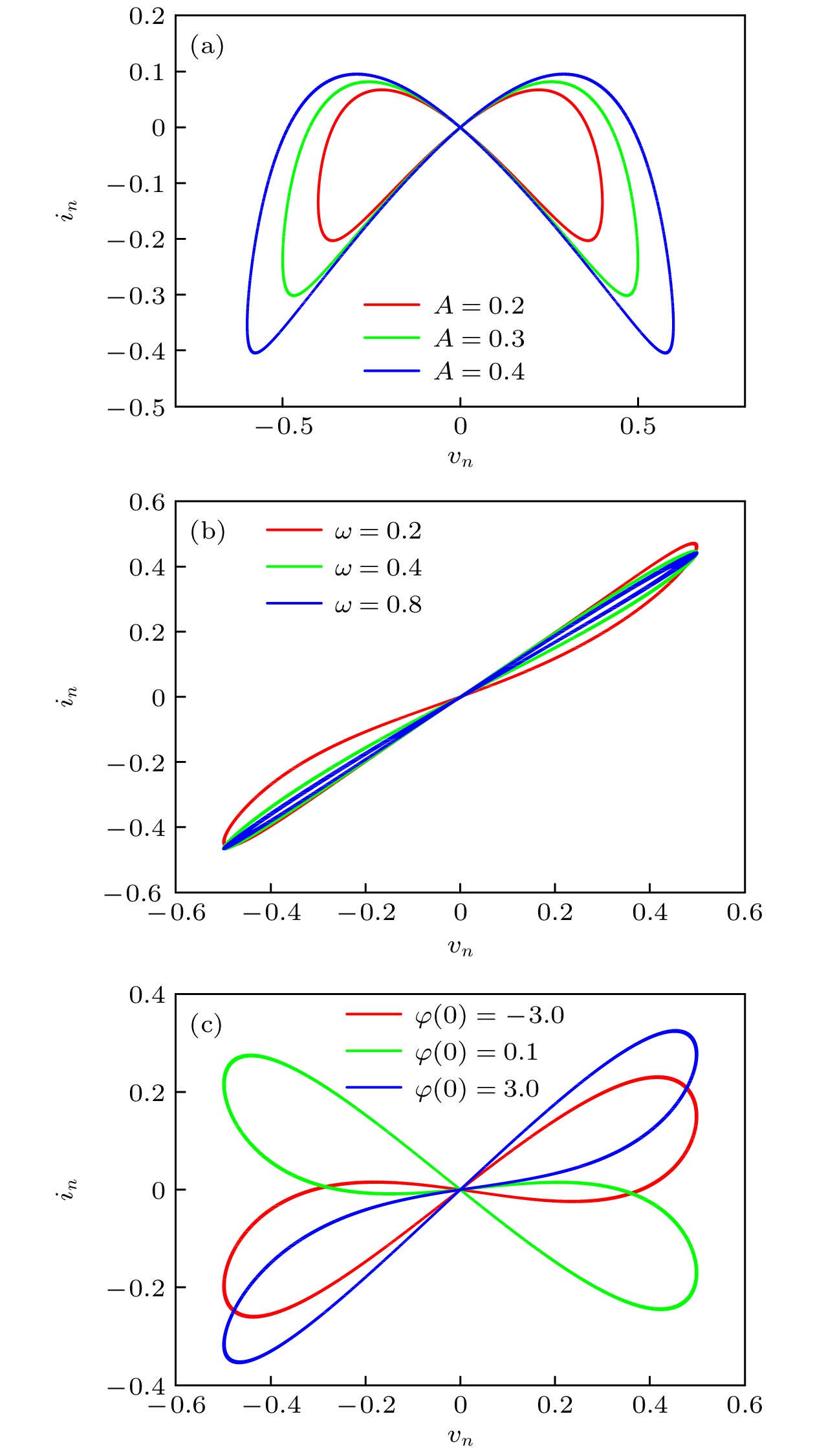
 DownLoad:
DownLoad:
